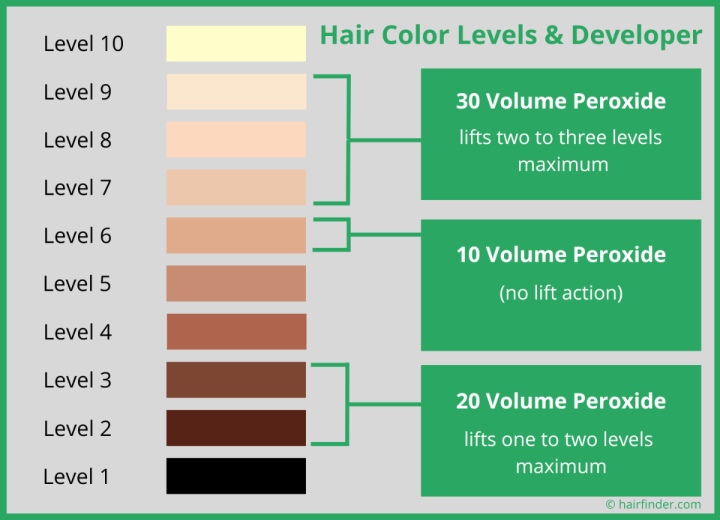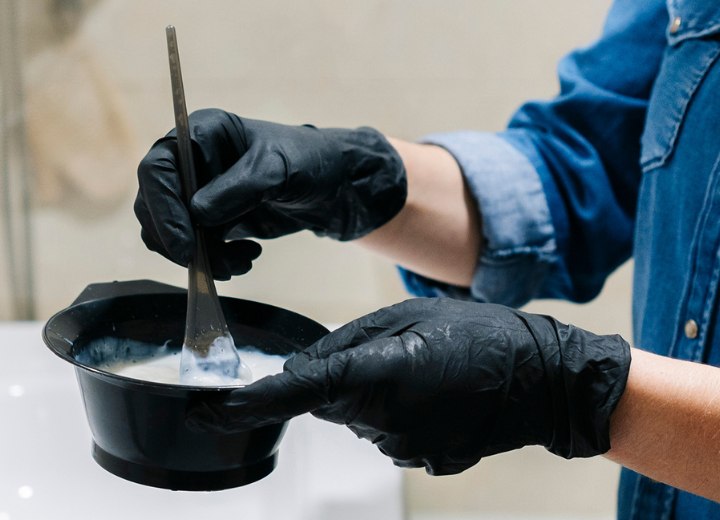Hair Color Levels and Peroxide Developer

In any discussion of hair color, it is important to talk about color level and developer. "Level" refers to the lightness or darkness of a particular hair color. It is shown on a scale of one to ten, with 1 being black and 10 being the palest blonde. The hair color formulas available also have a level on this same scale. This tells you how light or dark the final hair color will be.
"Developer" is the oxidizing agent that allows the hair color to do its job. Most permanent hair colors today use hydrogen peroxide as a developer. The peroxide opens the cuticles, allowing the color to penetrate. It also disperses the existing color and can lighten the hair's color level, depending on the strength of the peroxide formulation.
10-Volume Peroxide is a standard oxidizing strength for permanent, no-lift hair color. Designed for use when you simply want to add a tint or color tone to hair of the same lightness level, 10-volume peroxide opens the cuticle layer of the hair, allowing the color molecules to penetrate and be deposited in the cortex.
20-Volume Peroxide is also a common strength with permanent hair color and opens the hair cuticle like 10-volume, but also offers lifting of the hair's level by 1 to 2 levels. 20-volume peroxide is used to best effect when the hair's starting level is no more than one shade darker than the color you are trying to achieve.
30-Volume Peroxide works just like 20-volume, except that it will lift the hair's starting color by two to three levels and works best when the target color is no more than two levels lighter than the starting color. It is important to remember that the stronger the developer is, the harsher it can be on your hair. You should always use a moisturizing conditioner after applying a stronger hair color.
There are hydrogen peroxide developers that are stronger than 30-volume (there are also 40-volume and 50-volume formulas), but you should never use these strengths on your own. Developers with a volume strength of 30 or above work very quickly, and without careful monitoring, these formulas can damage the integrity of your hair.

You are likely asking yourself, "If 30-volume peroxide is the strongest developer you recommend, how do I get my dark brown hair (level 3) to blonde (level 8)?" The answer is relatively simple. You will need to use a lightener first. Lighteners are bleaching agents that are mixed with developers to decolorize, or lift the color from, the hair, usually in preparation for adding a lighter color tone or for creating dramatic highlights.
Lighteners come in two basic types: on-the-scalp and off-the-scalp. They are classified as such because they are designed to be safe when applied either on or off the scalp, as the name indicates. Off-the-scalp lighteners are much stronger and should never be used in such a way that they come into direct contact with the scalp, as they can cause chemical burns. These lighteners are generally designed for use with highlighting or frosting caps where they do not rest on the head.
On-the-scalp lighteners are formulated to be safely applied to the hair and to the scalp area. Often, on-the-scalp lighteners are slower-working, but infinitely safer for the scalp.
Using any lightener requires careful monitoring of the hair as it is being decolorized, as it can easily be over-processed. Once you have achieved the desired level of lightening, you can then color it as desired, and be confident that you will get the hair color you are trying for.
You should also remember that while hair color, when mixed with a developer, goes inert after 30 minutes, lighteners will remain active as long as they are moist. As a result, even a lightener mixed with only 10-volume peroxide can result in overprocessing if not watched carefully.
You also want to be careful that your hair is in good condition before you lighten it. Damaged or porous hair can become irreparably harmed by lightening.
©Hairfinder.com
See also:
Peroxide mixing formula
What does peroxide developer do?